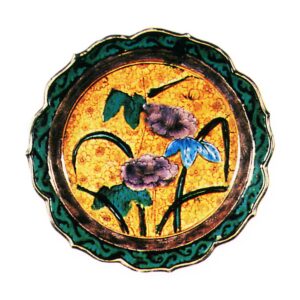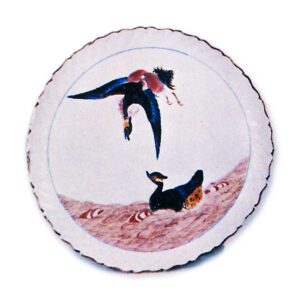

Kutani ware is produced in Kanazawa, Komatsu, and Kaga cities, as well as in three cities and two counties, Nomi and Enuma counties, in Ishikawa Prefecture. Mainly porcelain with overglaze painting. The name “Kutani-yaki” was first used in 1801-4, when it was mentioned in the book “Mugi-i Kikimon” written by Gomei Tsuka. Originally, Kutani-yaki was only fired in the Kutani area (Kutani-cho, Yamanaka-cho, Enuma-gun) for 30 or 40 years during the Ko-Kutani period and a few years during the Yoshidaya kiln. However, “Kutani-yaki” is rarely written on its products, and of course, there are no examples of Wakasugi Kiln, Minzangama Kiln, or Kasuga-yaki Ono Kiln of the same period bearing this name. However, in 1866, Eiraku Kazen came to the Yoshidaya kiln in Yamashiro Village (Kaga City) and began using the name “Kutani Eiraku Zou,” and potters in Yamashiro, Daishoji (Daishoji Town, Kaga City), Kanazawa and Nomi County suddenly followed his lead, Finally, “Kutani” became the name for all pottery produced in the Kaga area except for Ohi-yaki and hard ceramics.
In 1639, Maeda Toshiharu divided his domain to Daishoji, Enuma County, and had Goto Saijiro Sadatsugu, Tamura Gonzaemon, and others build pottery kilns in Sukezaka Village (Sukezaka-cho, Kaga City) and Kutani Village (Kutani-machi, Yamanaka Town) in the county to produce tea ceremony utensils. Toshiharu had the intention of creating porcelain, so he sent Sadatsugu’s son Tadakiyo to Hizen (Saga and Nagasaki prefectures). The secret method was firm, and he finally obtained several exiled potters from Ming China in Nagasaki, returned to his domain, and produced porcelain in his old home of Kutani. This is said to be called Ko-Kutani. However, due to the suspicion of the shogunate, it was discontinued in the first year of the Genroku era (1688-1704). About 100 years later, in the early Bunka period (1804-18), inspired by the creation of porcelain in Owari Seto, the Kanazawa Town Council, by resolution, invited Aoki Kibe from Kyoto to open a kiln at Kasuga-yama. In 1811, Honda Sadakichi, who came with Aoki, opened a kiln in Wakasugi, Nomi County (Wakasugi Town, Komatsu City), followed by the opening of the Yoshidaya kiln in 1824, and the appearance of blue used Kutani ware at the Hasudaiji kiln in Nomi County (Hasudaiji Town, Komatsu City) and the Matsuyama kiln in Enuma County (Matsuyama Town, Kaga City). The style of narrow patterns using red and gold started by Takeda Tamizan of Kanazawa at the end of the Bunsei period (1818-3O) spread to Ono (Ono-cho, Komatsu City) and Sano (Terai-cho, Sano) in Nomi County and Mikawa in Ishikawa County, and finally to Iidaya Hachiroemon of Yamashiro, who became the so-called Hachiro-te. During the Keio period (1865-18), Eiraku Wazen arrived at the Yamashiro kiln, followed by Kutani Shozo of Terai (Terai Town, Nomi County), Utsumi Kichizo of Kanazawa, and Matsumoto Saheira of Komatsu, who brought Kutani ware to the Meiji era to great success. However, since mass production was encouraged after the Bunsei Era, the variety became almost entirely commodities, and the quality declined. Later, around 1887 (Meiji 20), when Sunpei Enchu started exporting overseas, an unprecedentedly large production appeared, but this was accompanied by the adverse effects of overproduction. Improvements were made, and today, Kutani-yaki continues to thrive.
In a word, Kutani-yaki is not limited to the painting process. The geology of Kutani ware has changed in various ways, including Kutani porcelain, Kasugayama (Yamanoue-cho, Kanazawa City) ceramics, Wakasugi porcelain, Yoshidaya porcelain, Hachiman (Kaga Hachiman, Komatsu City), Ono and Sano semiporcelain, Awasuya stoneware, Yamashiro and Matsuyama porcelain, but the art of painting is still the main domain. Moreover, the techniques have changed in accordance with the trends of the times and have often been adapted to the nature of the base material itself. In the Ko-kutani period, the painting style was Kano style, with a masculine and dignified appearance in terms of surface, line, and coloring. Ai-Koya Kutani also has a unique calmness, and the indigo alone is dignified.
Wakasugi and Yoshidaya wares from the Bunka and Bunsei periods are more conventional in composition and have weaker lines. However, their strength lies in their expression of softness. The red painting of Minzangama, Onogama, and Iidaya kilns of the Tempo period (1830-44), influenced by the style of the literati and artists of the time, best expresses the mood of the period. Many of the Chinese designs were modeled after “Fang Shi Sumi Fu” and other works, and the red and gold colors on the egg-yellowish, lusterless ground corresponded very well with them. Around the time of the Meiji Restoration (1868-1912), a new style of colored gold brocade (sampu) began to emerge, in which Chinese rouge and Western-style burnished pigments were added to traditional colored glazes in abundance, but there was harmony among the many colors. This style was probably a reflection of the social conditions of the time. The transition and change in the post-Meiji period is boundless, as the world changes.
Potters who came from other regions: Honda Sadakichi of the Wakasugi Kiln (Omura, Hizen), Takeda Shuhei of the Tamiyama Kiln (Himeji), Eiraku Wazen and Nishimura Sozaburo of the Yamashiro Kiln (Kyoto), Seibei, Sadakichi’s adopted son (Shigaraki), Yujiro of the Wakasugi Kiln (Arita), Hirasuke (Hirado), Torakichi (Kyoto). Those who transmitted their techniques to other regions include Shozo (Noto Nashitani Kiln, Etchu Maruyama Kiln), Kikusaburo Matsuya (Settsu Sanda Kiln), Takeyama Soga and Fujizo Shuyama (Hida Shibukusa ware), Kansuke Murai and others (Omi Koto ware), and those who became famous Kyoto potters include Yohei Seifu I (Kanazawa), Bunsai Ogawa I (Wakasugi), Miyama Yoneya (Kanazawa). Yoneya Misan (Kanazawa), and others.
(Kutani Ceramic Kiln History, Kaga Ecchu Ceramic Koso, Kanazawa Industrial History, Kogyo Daijiten, Nihon Kindai Kogyo Shi, Heian Meitodo Den, Kutani Ceramic History)



